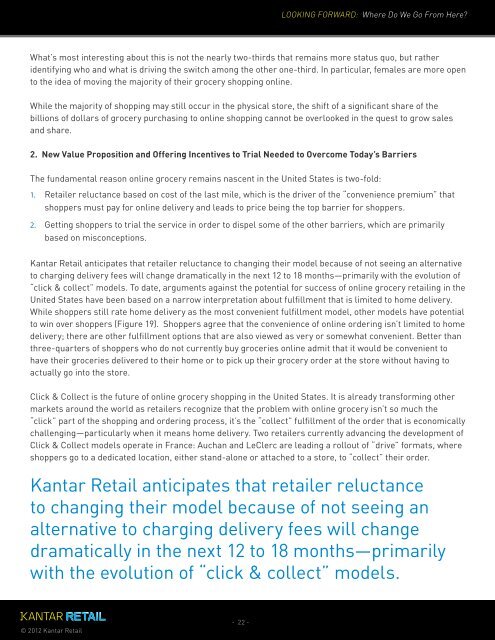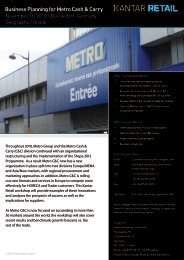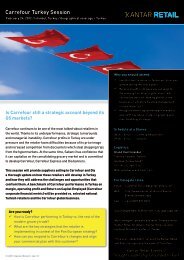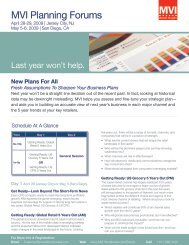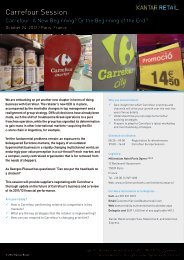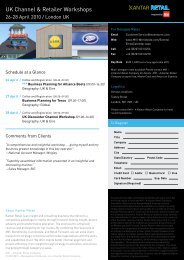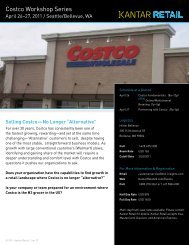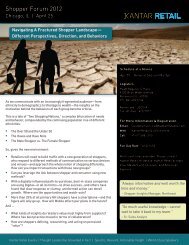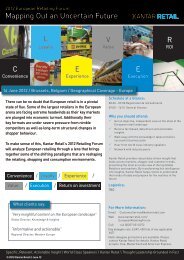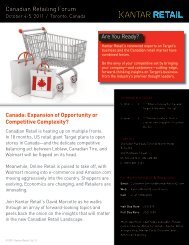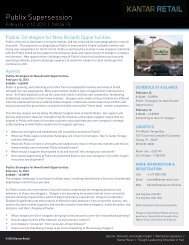The Future of Online Grocery Shopping in the United ... - Kantar Retail
The Future of Online Grocery Shopping in the United ... - Kantar Retail
The Future of Online Grocery Shopping in the United ... - Kantar Retail
Create successful ePaper yourself
Turn your PDF publications into a flip-book with our unique Google optimized e-Paper software.
© 2012 <strong>Kantar</strong> <strong>Retail</strong><br />
- 22 -<br />
LOOKING FORWARD: Where Do We Go From Here?<br />
What’s most <strong>in</strong>terest<strong>in</strong>g about this is not <strong>the</strong> nearly two-thirds that rema<strong>in</strong>s more status quo, but ra<strong>the</strong>r<br />
identify<strong>in</strong>g who and what is driv<strong>in</strong>g <strong>the</strong> switch among <strong>the</strong> o<strong>the</strong>r one-third. In particular, females are more open<br />
to <strong>the</strong> idea <strong>of</strong> mov<strong>in</strong>g <strong>the</strong> majority <strong>of</strong> <strong>the</strong>ir grocery shopp<strong>in</strong>g onl<strong>in</strong>e.<br />
While <strong>the</strong> majority <strong>of</strong> shopp<strong>in</strong>g may still occur <strong>in</strong> <strong>the</strong> physical store, <strong>the</strong> shift <strong>of</strong> a significant share <strong>of</strong> <strong>the</strong><br />
billions <strong>of</strong> dollars <strong>of</strong> grocery purchas<strong>in</strong>g to onl<strong>in</strong>e shopp<strong>in</strong>g cannot be overlooked <strong>in</strong> <strong>the</strong> quest to grow sales<br />
and share.<br />
2. New Value Proposition and Offer<strong>in</strong>g Incentives to Trial Needed to Overcome Today’s Barriers<br />
<strong>The</strong> fundamental reason onl<strong>in</strong>e grocery rema<strong>in</strong>s nascent <strong>in</strong> <strong>the</strong> <strong>United</strong> States is two-fold:<br />
1. <strong>Retail</strong>er reluctance based on cost <strong>of</strong> <strong>the</strong> last mile, which is <strong>the</strong> driver <strong>of</strong> <strong>the</strong> “convenience premium” that<br />
shoppers must pay for onl<strong>in</strong>e delivery and leads to price be<strong>in</strong>g <strong>the</strong> top barrier for shoppers.<br />
2. Gett<strong>in</strong>g shoppers to trial <strong>the</strong> service <strong>in</strong> order to dispel some <strong>of</strong> <strong>the</strong> o<strong>the</strong>r barriers, which are primarily<br />
based on misconceptions.<br />
<strong>Kantar</strong> <strong>Retail</strong> anticipates that retailer reluctance to chang<strong>in</strong>g <strong>the</strong>ir model because <strong>of</strong> not see<strong>in</strong>g an alternative<br />
to charg<strong>in</strong>g delivery fees will change dramatically <strong>in</strong> <strong>the</strong> next 12 to 18 months—primarily with <strong>the</strong> evolution <strong>of</strong><br />
“click & collect” models. To date, arguments aga<strong>in</strong>st <strong>the</strong> potential for success <strong>of</strong> onl<strong>in</strong>e grocery retail<strong>in</strong>g <strong>in</strong> <strong>the</strong><br />
<strong>United</strong> States have been based on a narrow <strong>in</strong>terpretation about fulfillment that is limited to home delivery.<br />
While shoppers still rate home delivery as <strong>the</strong> most convenient fulfillment model, o<strong>the</strong>r models have potential<br />
to w<strong>in</strong> over shoppers (Figure 19). Shoppers agree that <strong>the</strong> convenience <strong>of</strong> onl<strong>in</strong>e order<strong>in</strong>g isn’t limited to home<br />
delivery; <strong>the</strong>re are o<strong>the</strong>r fulfillment options that are also viewed as very or somewhat convenient. Better than<br />
three-quarters <strong>of</strong> shoppers who do not currently buy groceries onl<strong>in</strong>e admit that it would be convenient to<br />
have <strong>the</strong>ir groceries delivered to <strong>the</strong>ir home or to pick up <strong>the</strong>ir grocery order at <strong>the</strong> store without hav<strong>in</strong>g to<br />
actually go <strong>in</strong>to <strong>the</strong> store.<br />
Click & Collect is <strong>the</strong> future <strong>of</strong> onl<strong>in</strong>e grocery shopp<strong>in</strong>g <strong>in</strong> <strong>the</strong> <strong>United</strong> States. It is already transform<strong>in</strong>g o<strong>the</strong>r<br />
markets around <strong>the</strong> world as retailers recognize that <strong>the</strong> problem with onl<strong>in</strong>e grocery isn’t so much <strong>the</strong><br />
“click” part <strong>of</strong> <strong>the</strong> shopp<strong>in</strong>g and order<strong>in</strong>g process, it’s <strong>the</strong> “collect” fulfillment <strong>of</strong> <strong>the</strong> order that is economically<br />
challeng<strong>in</strong>g—particularly when it means home delivery. Two retailers currently advanc<strong>in</strong>g <strong>the</strong> development <strong>of</strong><br />
Click & Collect models operate <strong>in</strong> France: Auchan and LeClerc are lead<strong>in</strong>g a rollout <strong>of</strong> “drive” formats, where<br />
shoppers go to a dedicated location, ei<strong>the</strong>r stand-alone or attached to a store, to “collect” <strong>the</strong>ir order.<br />
<strong>Kantar</strong> <strong>Retail</strong> anticipates that retailer reluctance<br />
to chang<strong>in</strong>g <strong>the</strong>ir model because <strong>of</strong> not see<strong>in</strong>g an<br />
alternative to charg<strong>in</strong>g delivery fees will change<br />
dramatically <strong>in</strong> <strong>the</strong> next 12 to 18 months—primarily<br />
with <strong>the</strong> evolution <strong>of</strong> “click & collect” models.


